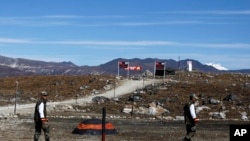Rapid construction of infrastructure along the China-Bhutan border near a strategic Himalayan plateau where Indian and Chinese forces were engaged in a standoff three years ago and new claims raised by China to a wildlife park in Bhutan have raised fresh concerns about Beijing pushing its boundaries in the Himalayan mountains.
Satellite images, produced by the U.S.-based satellite operator Maxar Technologies, show construction close to the Doklam Plateau, which is claimed by both China and Bhutan but is also of strategic significance to India.
"There has clearly been significant construction activity this year all along the Torsa River valley area with extensive road-building/construction activity underway as well as new military storage bunkers being built in China near the Doklam area,” according to a Maxar Technologies statement.
The construction includes a new village that some analysts who have studied the satellite imagery say lies inside Bhutanese-claimed territory. However both Bhutan and China have denied that that is the case.
“The new Chinese village shown in satellite images is inside Chinese territory and not inside Bhutan,” said Vetsop Namgyel, the Bhutanese ambassador to India.
Still, analysts say the infrastructure being built helps China reinforce its position in disputed areas.
“If you look at these activities, China is consolidating themselves in Doklam, the area they claim,” according to Manoj Joshi at the Observer Research Foundation in New Delhi who has studied the satellite imagery. “They are building a road, a village in a forest area where there is nothing to sustain it. By doing this, they are creating facts on the ground. This is what they have done everywhere such as South China Sea.”
India’s objections to a road being constructed by China on the Bhutanese side had led to a tense 2 1/2-month standoff with Chinese troops in 2017 – both sides withdrew when Beijing agreed to maintain the status quo in the area.
New Delhi had intervened on behalf of Bhutan to prevent China from gaining control of the plateau because it overlooks a narrow piece of land that connects India to its northeastern states.
“Doklam was not a victory as was claimed by many in India at that time,” said Joshi, who sees China’s push in the Himalayan mountains as part of a wider strategy to gain a dominant position in South Asia.
Sakteng Wildlife Sanctuary
Besides Doklam, a new area of concern for both India and Bhutan is China’s surprise claims to a huge swath of land encompassing a wildlife sanctuary in Bhutan.
Bhutan was caught off guard this summer when Chinese representatives raised objections when it sought funding from U.S.-based Global Environmental Facility for the Sakteng Wildlife Sanctuary, calling it disputed territory.
Bhutan rejected the assertion but was shocked by the move because it had never been part of disputed areas discussed between the two countries previously.
“According to all our records, Sakteng has always been our territory,” Bhutanese historian Karma Phunstho said.
The new territory flagged by China is bigger than other disputed areas on which the two countries have held two dozen rounds of negotiations since 1986.
Analysts see the move as part of the wider bid by Beijing to gain an advantage in its territorial disputes with India. The sanctuary adjoins the Indian state of Arunachal Pradesh, which Beijing claims is part of south Tibet.
The question raised over Sakteng could be a pressure tactic on Bhutan, which so far has not made concessions on Doklam to Beijing in deference to Indian sensibilities, according to a Bhutanese analyst who did not want to be identified.
“All official Chinese maps also show Sakteng as a part of Bhutan,” he said. Bhutan has traditionally been a close ally of India.
However, for the tiny nation of 750,000 that has remained largely insulated from the world, the emerging worry is being caught in the rivalry between India and China.
“Bhutan has to be on its toes and be cautious as these geopolitical games are played out. We worry about being dragged into the tensions in our region and are wary of their agenda,” said Phunstho.
Tensions between India and China are at their worst in decades with both sides involved in a tense military standoff on the other side of the Himalayas in eastern India. Tens of thousands of soldiers from both sides are deployed on icy peaks as the two countries spar over their disputed border.









